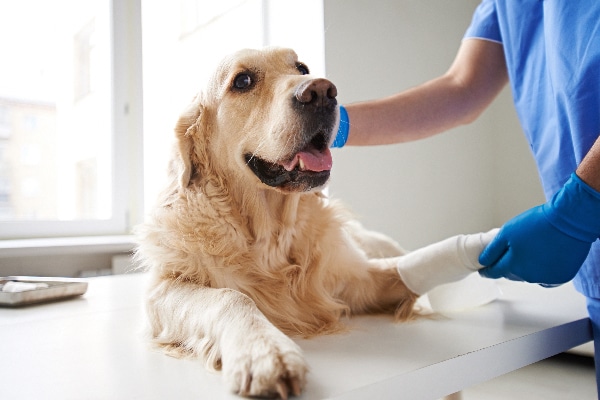The post Is Your Dog Limping? Here’s Why & How to Help by Stephanie Osmanski appeared first on Dogster. Copying over entire articles infringes on copyright laws. You may not be aware of it, but all of these articles were assigned, contracted and paid for, so they aren’t considered public domain. However, we appreciate that you like the article and would love it if you continued sharing just the first paragraph of an article, then linking out to the rest of the piece on Dogster.com.
If you’ve noticed your dog limping, it’s natural to want to get to the bottom of it. After all, unlike humans, our pets can’t articulate what’s hurting and how it happened to them. As doggie parents, it’s up to us to check for symptoms and to decide when it’s time to take our limping dog to the veterinarian.
“Dogs can get strains and sprains and break bones, just like people,” explains Purina veterinarian Dr. RuthAnn Lobos. “Some infectious diseases, particularly those spread by ticks, can also cause joint pain and limping. [It’s] always best to check with your veterinarian when your dog starts limping in order to identify the cause and develop a treatment plan to help get back on all four of his paws as quickly as possible!”
So, how do you tell when dog limping is a reason to see the vet? Keep reading for everything you need to know about dog limping – why it happens and how to help!
Different types of dog limping

Dog limping can happen for several different reasons. Photography © mediaphotos | iStock / Getty Images Plus.
Dog limping can happen for many different reasons. There are two main kinds of limping: gradual onset and sudden limping.
Sudden limping refers to a limp then generally comes on quickly, most likely after some kind of significant trauma or injury, while gradual onset refers to underlying chronic conditions. With dog limping, these chronic conditions could include osteoarthritis, dysplasia or Lyme disease.
What causes dog limping?
Paw injuries, joint issues or disease, bone disease, and other general types of injury or trauma are the most common causes of dog limping.
“First, check the paws,” says Dr. Lobos. “Oftentimes, we look to the elbows, wrists, ankles and knees and forget to look see if there is something stuck in their pads or between their pads.”
When a dog’s paws or paw pads are agitated by a foreign body, it’s not only uncomfortable for the dog, but ultimately, it could lead to a dangerous infection. Other minor injuries like insect or animal bites or stings could potentially cause tenderness to the affected area, therefore resulting in limping. After inspecting a dog’s paws, toenails are another area pet owners should pay attention to.
“Broken toenails can be painful and certainly cause limping,” Dr. Lobos adds. Burns, frostbite, bruising and any kind of cut could also be the root cause of dog limping.
Dog limping in dogs of different sizes
Different kinds of ailments can also target dogs depending on size. “For medium- to large-size dogs, a top cause for acute limping is a torn cranial cruciate ligament (CCL). In people it is known as their ACL, in dogs, it’s their CCL,” Dr. Lobos explains.
“In smaller breed and toy breed dogs, they can have a condition called luxating patellas that can cause them to limp intermittently,” Dr. Lobos says. “This is where their knee caps will slide abnormally in and out of the groove in their femur.”
Symptoms of dog limping

Dog limping isn’t always very obvious. Photography © Smyk_ | iStock / Getty Images Plus.
Because dogs can’t talk to tell us what’s hurting or bothering them, it’s important to pay attention to their behavior in order to identify symptoms. And sometimes dog limping isn’t as obvious as it might seem.
“Sometimes, dogs will show pain by licking the affected area or trembling in the affected leg,” Dr. Lobos explains. “They can also sometimes become protective of the area and shy away when touched.”
When is dog limping a symptom of other issues?
Limping might not even be your dog’s issue. In fact, it might just be a symptom of another problem altogether.
As mentioned above, smaller breed and toy breed dogs may suffer from luxating patellas and larger dogs might battle CCL issues.
Older dogs are also more at risk for limping. “Older dogs can limp from osteoarthritis that can affect any limb and even their neck and back,” Dr. Lobos explains. “As large breed dogs are also at risk for development of osteosarcoma, a type of cancer that affects the bones, it can be a cause of acute limping.”
Dr. Lobos explains that other orthopedic conditions — “such as hip dysplasia, elbow dysplasia and osteochondrosis dessicans (a condition that affects the cartilage development, particularly in younger dogs) — can also cause limping.”
Unsure if your limping dog needs vet attention?

A dog getting his paw bandaged. Photography © didesign021 | iStock / Getty Images Plus.
If you’re unsure if your pet’s symptoms are severe enough to warrant a visit to the vet, it’s always best to contact your veterinarian and explain the situation. If a dog isn’t putting weight on a specific limb or is crying, definitely consult a vet immediately.
“Depending on the severity of the limping — if they won’t put weight on the limb, are vocalizing from pain, or there is an open wound, they should be seen as soon as possible,” Dr. Lobos recommends. “It’s always best to err on the side of caution and take them in whenever they are not walking normally.”
How can you help a limping dog?
What can you do to alleviate the pain associated with dog limping?
“Depending on the severity of the limping and injury, comforting the dog until they get to the veterinarian can be very helpful in settling the mind of the dog so the veterinarian can do the best job possible on their physical exam,” Dr. Lobos says. “If there is a cut that is bleeding, applying a light bandage to the area until they get to the vet’s office can give the dog a less painful surface to stand on — if the cut or injury is on the pad or paw.”
According to Dr. Lobos, pet owners should refrain from giving medications to their dogs.
“Avoid giving any human medications, as they can be toxic to the dog or interfere with the medication that the veterinarian might want to prescribe for pain,” Dr. Lobos says.
How to treat dog limping
Once at the veterinarian, how is dog limping identified and treated? According to Dr. Lobos, veterinarians will focus on the symptoms displayed in order to choose an appropriate treatment plan for dog limping. This could include pain meds, a splint or brace, icing of a wound or irritated area, or heating of an area that experiences chronic pain.
“Depending on the injury, [veterinarians] may give pain medication, place a split or brace, recommend ice (for acute injuries) or heat (for more chronic issues), or perhaps recommend surgery and physical rehabilitation,” Dr. Lobos explains.
In Dr. Lobos’ own words, it’s always best to err on the side of caution and consult a vet when it comes to dog limping.
Thumbnail: Photography ©SVPhilon | iStock / Getty Images Plus.
Read more about dog health and care on Dogster.com:
The post Is Your Dog Limping? Here’s Why & How to Help by Stephanie Osmanski appeared first on Dogster. Copying over entire articles infringes on copyright laws. You may not be aware of it, but all of these articles were assigned, contracted and paid for, so they aren’t considered public domain. However, we appreciate that you like the article and would love it if you continued sharing just the first paragraph of an article, then linking out to the rest of the piece on Dogster.com.
No comments:
Post a Comment